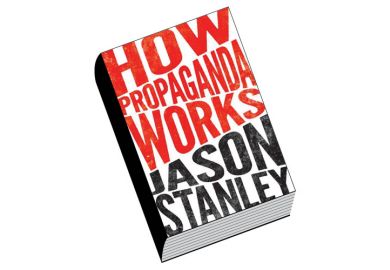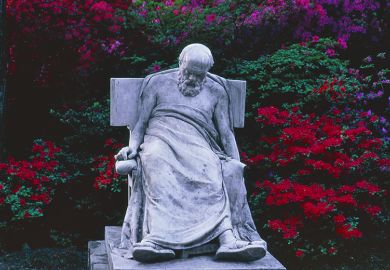It’s System 1, fast thinking, that sees the title How to Think and wants to buy the book. It’s System 2 that reads the subtitle, realises this is more of a psychological exploration and hesitates… John Paul Minda nods at the confusion over aims at regular intervals (“after all, there’s not one way to think”) but suggests that if you understand the mechanisms of your mind better, then it should also help you to improve your thinking skills.
At times, that seems a stretch. Learning more about “subcortical structures” doesn’t seem to supercharge my thinking any more than studying assembly language would help me to word-process my essay. Nonetheless, I think this is a useful book for both students and professors – who, let’s face it, are supposed to think.
Basically, Minda has produced a grand survey of the brain. It’s one that he hopes people will “pick up and read during summer vacations”, but even if that seems a stretch, it does offer intriguing insights, particularly into the evolutionary mechanisms that lead us to take thinking shortcuts even when they mislead.
Also included is a dose of logic, seen as the template for the correct way to think, alongside some of the latest thinking in cognitive psychology, seen as offering a window on all the ways in which humans fail in this respect, directly following Daniel Kahneman and Amos Tversky’s influential work in this area. Minda argues that we fall prey to “all manner of cognitive biases and illusion”, as a result of which we display overconfidence, fail to consider contradictory evidence and, generally, look no further than the ends of our noses. Yet he also claims, and I think rightly, that these kinds of errors are not only what make us human, but arise directly from the same cognitive processes that also allow us to learn, think and remember.
It is refreshing not to be offered simplicities since in real life, if not in logic, things can be both good and bad. Take “multitasking”, for example. Yes, it saves time, but, we read, “there’s always a cost to multitasking no matter how good you think you are at doing two things at once”. A topical example of psychological research is an investigation of the effects of keeping an eye on your mobile phone while listening to a lecture. Contrary to the everyday experience dubbed the “cocktail-party phenomenon”, which says you can put your phone on your desk and still listen, Minda warns that this diversion of the mind’s resources comes at a price.
Not checking your phone during class is a rare practical tip, though, in a book that generally feels like a CogSci 101 course. Minda is proud of progress in the field, saying: “It is only in the last hundred years that humans have been able to study thinking and cognition in our modern scientific way.”
I have great problems with this kind of language, partly since it frames the debate, which Minda himself warns is one of our most pervasive thinking errors. His foray into coronavirus policy is a case in point. He makes a lot of the New York mayor’s advice to citizens to “keep calm and carry on” (my paraphrase), warning that this amounts to thinking of the virus as similar to earlier threats, whereas it was in fact “too new and too different” for strategies used previously to work. Yet other frames would have seen the virus as far from new, as a “variant” of Sars, as a member of the family of coronaviruses or indeed as belonging to the whole general class of seasonal respiratory illnesses (which regularly take a heavy toll without society being shut down).
But there is another issue in relation to Minda’s high valuation of science, which some of his own examples reveal. Take the case of language acquisition, which B. F. Skinner, apparently so very scientifically, demonstrated was a stimulus-response behaviour. Yet How to Think reports Noam Chomsky’s argument that children obviously generate far more complex language than their limited exposure to Mom and Pop’s entreaties to “eat more yum-yum” and so on would imply, and that this ability reflects some kind of “innate grammar”. Such debates underline the fact that something can be “modern science” but still wrong.
Generally, however, Minda seems to believe that thinking problems are caused by not being modern enough. So, for example, the behaviourists’ error was to limit their model of the mind to inputs and outputs and to miss the science of internal states. Today, we can thank computers for making it possible to see the importance of the circuit connections. Warming to this theme, Minda describes how algorithms affect us both internally and externally and how those run by Google and Facebook alter society, while those run by our minds alter our brains.
Central to his account is the role of memory, seen as “reconstructed perception”. However, Minda acknowledges that perception is also partly constructed using memories – and, as all physicists know, feedback can lead to very odd effects. Remember, too, that memories are organised using semantic content. This is why we find it hard to remember random words but can remember information that is linked up in some way.
In sum, Minda suggests, human language “is the engine of thought”. Alas, like Kahneman and Tversky, he does not seem to appreciate the subtlety of the ways in which we use words, particularly as metaphors, an aspect explored by Douglas Hofstadter and Emmanuel Sander in their doorstopper of a book, Surfaces and Essences: Analogy as the Fuel and Fire of Thinking (2013). But at least he briefly notes how the inner voice likes telling stories, while warning that it’s not too fussy about whether the stories are literally true, slanted by false memories – or just made up; perceptions and even information that do not fit our mental stories may be downgraded or ignored.
All this reminds me of Plato’s suggestion, all those years ago, that our thoughts are built up out of concepts – the ones he called “the Forms”. Indeed, Minda warns, without concepts “every experience would be unique”. We would not be able to recognise things and would be lost.
The final part of this survey consists of tales about what happens when the brain gets things wrong. These are the curious and usually rather tragic stories of people whose frontal lobes are damaged in accidents and evergreen examples of optical illusions. Much of this has already been well described by people such as Paul Broks, whose Into the Silent Land (2004) is a more insightful neuropsychological adventure than Oliver Sacks’ better-known The Man Who Mistook His Wife for a Hat and Other Clinical Tales (1985). However, Minda does offer an extra insight into one phenomenon, blindsight (the illness where the “input” required for vision is faulty), by describing how movement can provide an alternative route for seeing.
In short, as the blurb says on the back, “this book will get you thinking about thinking”, and that is no small thing.
Martin Cohen is a visiting lecturer at Pau University and the author of several books on thinking skills, including Critical Thinking Skills for Dummies. His new book about strategic thinking is due out in 2022.
How to Think: Understanding the Way We Decide, Remember and Make Sense of the World
By John Paul Minda
Robinson, 368pp, £14.99
ISBN 9781472143037
Published 29 April 2021
The author
John Paul Minda, professor of psychology at Western University in Ontario, was born in Pittsburgh and grew up outside the small Pennsylvania town of Saltsburg. Most of his early years, he recalls, were made up of “time in the woods, lots of reading and games, and a fair amount of time alone, too. I think this helped to cultivate my love of introspection because there were few other kids around. Aside from my two younger brothers and one other boy in a nearby house, there were no other kids within walking or biking distance. So, I spent time reading. And, believe it or not, my plans were to either be a priest or maybe a plumber. In some ways, professor of psychology is not far off.”
Since he studied at the small Hiram College in north-east Ohio, where “there were few research-active faculty and no graduate students” but the faculty “excelled at teaching”, Minda acquired “a love of teaching which I carry to this day”. Though it took him a while, therefore, to decide on an area of research, he now works in the Brain and Mind Institute at Western, looking at “how people organise their experiences into concepts and how they use those concepts to make decisions. A lot of this work looks at the fundamental cognitive and brain mechanisms of how new things are learned, but I’ve also extended some of this research into looking at how concepts enable good thinking. For example, I’ve studied expert physicians and found that they rely on ad hoc categories when making decisions about how to manage different kinds of patients.”
Asked for a few handy hints about how to think better, Minda suggests that, while we inevitably rely on heuristics or shortcuts to make decisions fast, it is a good idea to “stop and check yourself every so often to make sure you’re making good decisions and recognise your limits”. We should bear in mind that “mistakes and errors are often how we improve”. And, just as with everything else in life, practice is crucial: “So, practise making good decisions. Practise thinking clearly. Make time to just think about things.”
Matthew Reisz
Register to continue
Why register?
- Registration is free and only takes a moment
- Once registered, you can read 3 articles a month
- Sign up for our newsletter
Subscribe
Or subscribe for unlimited access to:
- Unlimited access to news, views, insights & reviews
- Digital editions
- Digital access to THE’s university and college rankings analysis
Already registered or a current subscriber?








